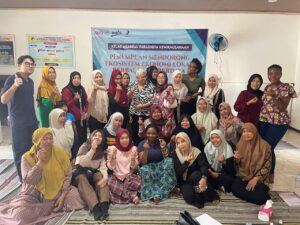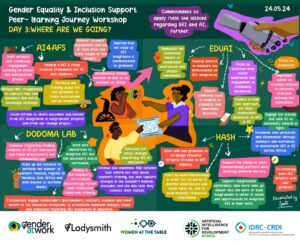by CHLOE SAFIER
A few weeks ago, journalist Ed Yong documented his attempt to address the gender imbalance in his writing for The Atlantic. He noticed that in 2016, only 24% of his sources were women and 35% featured no women’s voices at all. Once he started to pay attention to the lack of women in his writing, by tracking it on a spreadsheet, he was able to remedy the imbalance: after just four months, he had reached near gender parity in his sources and quotes. He also discovered that the prevailing skepticism about the ease and accessibility of finding women experts was inaccurate. Once he started to be intentional about it, women experts were readily identifiable.
Yong recognized that gender biases are replicated and perpetuated in media. It matters that men are more often named as experts and that their voices are more often heard in the content we consume. Journalists and content producers carry some of the responsibility for ensuring their gender biases do not seep into the way they structure and research their work, and for what they put out into the world. This is particularly important in light of the recent revelations that media companies are not always welcome places for women to work, and that the gender biases held by individuals and organizations can have multitude kinds of impact. We are in an important cultural moment where there is momentum to examine all dimensions of gender discrimination, from the pay gap to sexual harassment to representation and stereotypes in media production and content.
In the fall of 2017, IFEX, a network of organizations that works to defend and promote freedom of expression, undertook a more comprehensive type of review: a gender audit. IFEX produces original content and aggregates information about freedom of expression from multiple platforms and grassroots organizations. Over the course of several months, I worked as a consultant with IFEX staff to understand how the organization represents gender and sexual diversity in its production and public facing content, to identify the gaps, and to figure out how those gaps could be addressed. I also looked at who produces their content, and how those content producers understood gender and sexual diversity issues. And I looked at how those who read IFEX articles understand the organization’s approaches to gender issues, to explore the possibility of a gap between the intention and the uptake of the messaging that IFEX shares with its audience.
What’s next?
The results of the audit demonstrate that IFEX is already being thoughtful about gender issues. That aligns with the organization’s interest in commissioning a gender audit; many organizations don’t consider the way gender impacts their work or content. It also indicated areas for improvement, especially when it came to improving gender disaggregated data, and increasing the capacity of content producers to understand how gender and sexual diversity issues linked to their work. The audit allowed me to make concrete recommendations, and it also serves as a baseline against which IFEX can measure their progress. One of the recommendations was to run the same audit every three years, to track how things are improving.
Gender audit tools are not, in and of themselves, a magic bullet. This kind of tool provides a clear and effective way of generating a digestible snapshot about how an organization is performing on set gender metrics, and in an ideal world, it is accompanied by a longer, more engaged process of exploring personal biases and understanding organizational culture, and supporting content producers to generate both the political will and depth of knowledge to produce content that is deeply reflective of gender equal values.
This audit supports IFEX’s broader strategy of work to ensure gender and sexual diversity is prioritized throughout the organization. The results were shared with the content producers, and the recommendations will now be driven forward by a senior leadership that is both enthusiastic and dedicated to making gender equality a priority.
In light of International Women’s Day, it is time to re-think the status quo and understand the ways in which gender inequality pervades so much of how we think and what we produce. Gender audit tools can be adapted to all sorts of contexts, organizations and media. But they are just one small part of a much bigger toolbox needed to address deeply rooted inequalities in our culture.
Curious about the methodology?
To create the tool, I focused on four areas of interest, roughly based on UNESCO’s gender sensitive indicators for media: coverage, fair portrayal, balanced production and understanding. The audit of IFEX’s coverage explored how the issues related to gender & sexual diversity are represented in IFEX’s content. To understand this, I reviewed a sample set of articles that IFEX had produced over the past year and collected data around questions like: how many articles focus primarily on gender issues, how many mention gender, how many are inclusive of gender and how many are gender blind? How many of the photos that accompany the articles feature women, men and/or LGBTQI+ people? I then reviewed IFEX’s website, to determine the ease of identifying gender-focused or gender-inclusive content on the website, and to understand how a website visitor may perceive IFEX’s coverage of gender issues.
The fair portrayal section of the audit set out to understand if IFEX’s original content reinforces existing gender inequalities and norms, or if it promotes multi-dimensional representation, by challenging gender-based stereotypes. To do this, I had to identify gender stereotypes and create a baseline; I adapted the Gender Results Effectiveness Scale to create that. I reviewed the articles in my sample set, and asked questions like: how many articles reinforce gender stereotypes? How many challenge stereotypes, and how many are neutral? I also looked at representation: how many women were quoted, and when they were quoted, how many were experts, survivors, or victims? I identified a few articles that served as best practice to highlight in the report, and a few that demonstrated what not to do, so IFEX staff could understand in clear terms what was expected of them when it came to portraying women and LGBTQI+ people. I also looked at images, pictures, and videos, and documented where those depicted, challenged or remained neutral on gender stereotypes. I employed IOM’s Gender & Communications Toolkit for guidance and visual examples of images that perpetuate and subvert stereotypes.
The balanced production section of the audit sought to understand if there was an equal balance of women and men who produce original content for IFEX. This section also explored whether content producers at IFEX have the knowledge, resources and confidence to write about and integrate gender and sexual diversity into their content. In addition to counting up the number of articles written by women or men in my sample set, I surveyed and interviewed content producers. That way, I was able to get an anonymized, big picture understanding of whether content producers thought about how to include gender and sexual diversity and what went into those decisions. Interviews allowed me to delve deeper into the ways in which they understood gender concepts, and what the circumstances and barriers were to including gender and sexual diversity issues in their articles. It was interesting to notice discrepancies between the quantitative and qualitative analysis: in some cases, content producers suggested knowledge or confidence around integrating gender, but there was a barrier when it came to actually doing it. The interviews allowed me to hone in on why that was happening.
The last section of the audit was focused on understanding, and looked at how IFEX’s original gender-focused content contributes to their readers’ understanding of the gender dimensions of freedom of expression. This was the most challenging data to gather. I choose to utilize focus groups and end-of-article surveys, to gage whether IFEX’s articles generate a new understanding amongst readers, while keeping in mind that that is extremely difficult to measure: IFEX’s work can only attempt to contribute (as one of many influences) to the way their readers understand gender issues.
This article was originally published on March 7, 2018 on www.ifex.org.
Photo Credit: J.M. Giordano/SOPA Images/LightRocket via Getty Images
Author:
Chloe Safier is a women’s rights, gender, and global development consultant.



